Anthropogenic global warming (AGW) is a real risk for future generations including my own children. It’s a risk I’ve personally taken seriously, and have taken personal action against, since the late 1980s when I was in university. And while we’ve seen some extremely positive developments in the past 30 years such as the creation of new industries to generate wind power, solar power, electric vehicles, biofuels, LED lighting etc., this has barely moved the needle on the root causes of AGW: fossil greenhouse gas (GHG) emissions and land use changes made by humans.
Why have we not taken more action? We knew about AGW thirty years ago- the science was quite solid even back then. The reality is, we ignored the science because many people- ordinary voters AND the people in power who report to them- refused to believe it. Many continue to do so to this today. And why is that? Human motivations are complicated, but I see two key root causes. One is that the worst harms from AGW aren’t likely to be experienced by the generation making the emissions, but rather by future generations, i.e. people may love their children, but not enough to avoid spending their inheritance in this sense. The other is that they’ve been fed a series of lies, in part by parties interested in profiting from the status quo as long as possible, which allow people to cling to a shred of doubt about the underlying science which is, frankly, not supportable by the facts.
The risk of AGW hinges ultimately on three facts. These are indeed facts- things we know, based on measurements- generally multiple measurements which compare favourably with one another. Each of the three facts also has sound theoretical underpinning, meaning that we not only know them to be facts, but we know both why they’re facts and also why they’re important. And these three facts are not the subject of credible dispute in the scientific community. They are not the topic of active discussion in the peer-reviewed journals on the subject, which has another name- the repository of the current state of human knowledge on the topic.
Here are the three facts, one by one, along with peer-reviewed scientific references, or more accessible references which themselves refer to the underlying scientific papers, which will allow you to assure yourself that I’m not just making this up.
Fact #1: Atmospheric CO2 Concentrations Have Increased
We started burning fossil fuels in earnest in the 1720s when the first, highly inefficient steam engines were invented. These engines were in part used to power pumps- in coal mines. Steam engines were in that sense a recursive technology, i.e. one that enables and magnifies its own success. The burning of fossils freed us in a sense from what was at the time, the terrible burden of energy sustainability without modern technology. We no longer needed to balance our need to stay warm against the rate at which trees grew to make firewood for us as just one example.
For the millennium before that, atmospheric carbon dioxide (CO2) concentrations were stable, bouncing around near 280 ppm. They did change a bit as we de-forested much of Europe to provide firewood, through the so-called Mini Ice Age and Medieval Warm Period, and then as we hewed down North America’s forests and burned them too. But for 1000 years, the concentrations remained more or less stable.
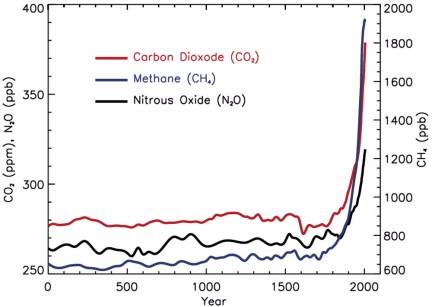
https://www.acs.org/content/acs/en/climatescience/greenhousegases/industrialrevolution.html
This means that the carbon cycle was more or less in balance. Flows of CO2 and methane up into the atmosphere from respiration of animals and plants, desorption of CO2 from the oceans, decay of organic matter, emissions from methane seeps and volcanoes etc., were in balance with flows of CO2 out of the atmosphere due to photosynthesis, dissolution into the oceans, soil organic carbon generation, oxidation of methane to carbon monoxide (CO) and CO2 in the upper atmosphere, weathering of silicate rocks and the big final sinks- oceanic sequestration, i.e. the conversion of CO2 into carbonate rocks and the permanent burial of oceanic sediments containing biomass. That both the natural up- and down-flows of CO2 and methane are positively massive in fact doesn’t matter- what matters is that they were in balance.
But when we look at the concentration of CO2 in the atmosphere, as measured in bubbles of air trapped in ice cores primarily, what we see is that CO2 concentration was surprisingly consistent: from the Law Dome ice core data, the precision of the CO2 concentrations is estimated at +/- 1.2 ppm, and the observations over the pre-industrial period to about 1006 AD were 275 to 284 ppm. The concentrations started to rise as we started to burn fossils in earnest.
https://cdiac.ess-dive.lbl.gov/trends/co2/lawdome.html
Since the 1960s, independent groups have been continuously monitoring CO2 concentrations in the atmosphere, most notably at the Mauna Loa observatory in Hawaii. The concentrations show a continual increase year after year, with a “sawtooth” of small seasonal changes up and down each year. The “sawtooth” arises from changes in seasons on Earth- there is more photosynthetic plant life in the northern hemisphere than the southern, so when the north is in summer, CO2 concentrations drop a little- only to rise again in winter.
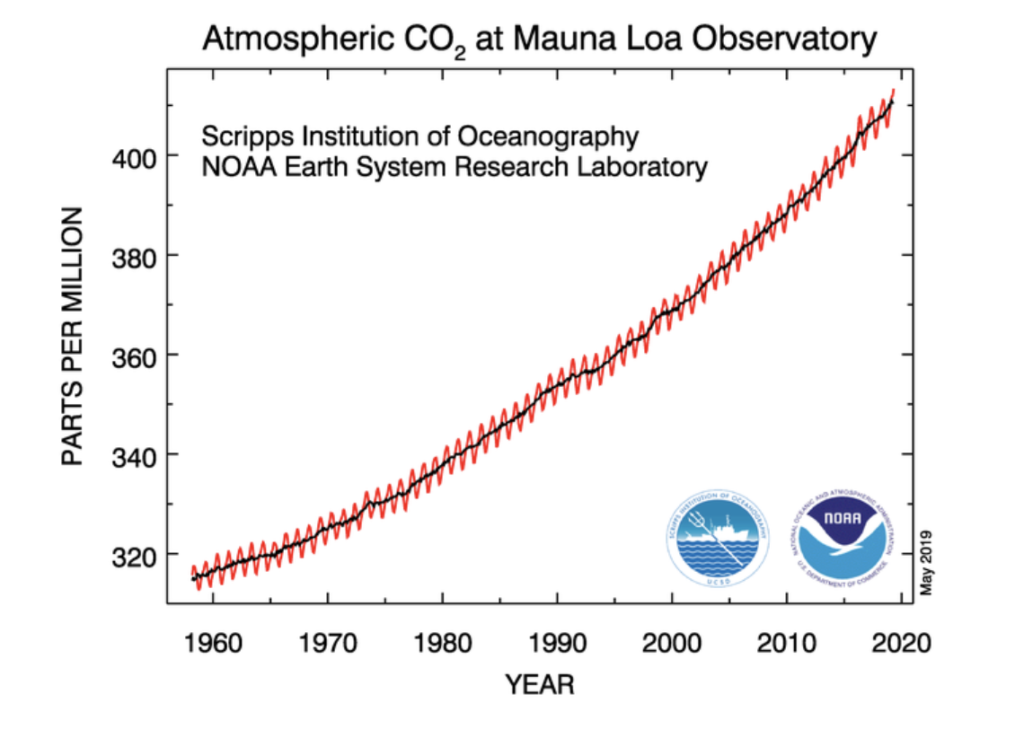
CO2 concentrations have recently reached 415 ppm- a concentration not encountered in the past approximately 1,000,000 years. CO2 has never been this high since there was anything recognizable as a human on the planet.
https://www.co2.earth/21-co2-past
(pic from Luthi et al)
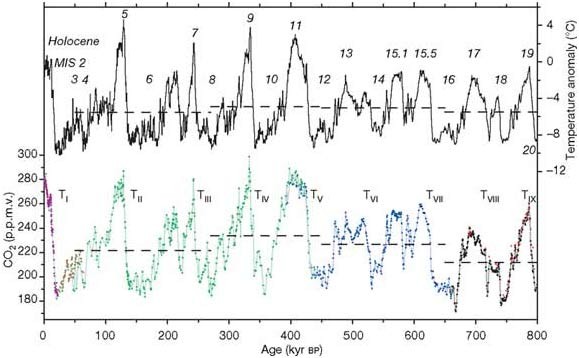
Source https://www.nature.com/articles/nature06949
CO2 has gone up, rapidly, from a stable level, and continues to increase as I write this. So, sadly, have the concentrations of methane, N20, and other so-called “greenhouse gases” (GHGs).
This is a fact, not something a credible person can argue with.
Fact #2: We Caused The CO2 Increase, Primarily By Burning Fossils
It isn’t sufficient to say that CO2 went up “suspiciously” as our emissions of fossil fuels went up- that is an argument from correlation which does not prove causation. What we can say is that the increase in CO2 concentration is consistent with the theory that fossil fuel burning caused this rise, but though it looks suspicious, this alone absolutely isn’t sufficient proof.
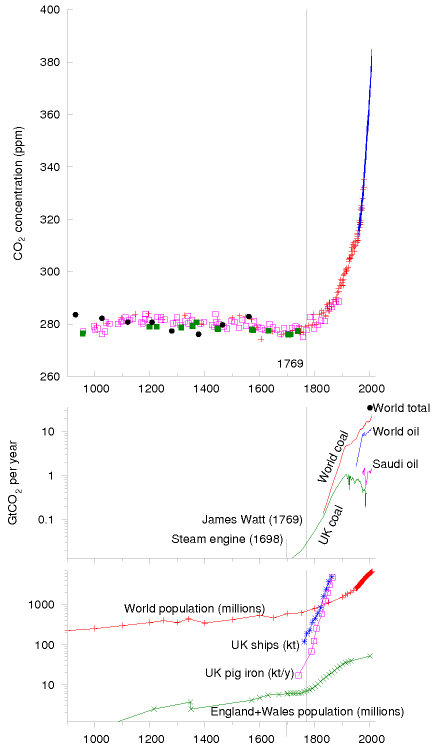
Source http://withouthotair.com/c1/page_9.shtml
(Aside: if you care at all about AGW, or renewable energy, or both- reading the late David Mackay’s brilliant work at www.withouthotair.com from beginning to end is your first minimally necessary step in educating yourself about the issues we’re up against in my opinion. It’s very accessible and its conclusions very clear: dealing with AGW is absolutely necessary but it will be a very challenging problem because we use a lot of energy and hence burn a lot of fossil fuels right now)
There are however two measured facts which prove conclusively that the new CO2 in the atmosphere is primarily there as a result of our burning of fossil fuels.
The first is simple carbon mass balance accounting. We can fairly accurately estimate how much fossil fuel we’ve burned, since fossil fuels a) cost money and b) are taxed. A scientific accounting of the amount of fossil fuel burning does demonstrate that not only did we produce enough CO2 to cause atmospheric concentrations to rise by the amount they did (proven by measurement above), but we actually emitted TWICE THAT MUCH:
https://pubs.acs.org/doi/10.1021/ef200914u
Where did the other half go? Some of it went into the oceans, as would be expected by anyone who understands a little physical chemistry. As CO2 dissolves in water, the pH of the water decreases. Acidification (decreasing pH) of the surface oceans has indeed been measured, and has occurred because of the increased CO2 concentration in the atmosphere. This too is of concern to ocean life such as corals and shelled sealife which rely on carbonate fixation as part of their lifecycle.
The rest went into the biosphere.
https://www.annualreviews.org/doi/abs/10.1146/annurev.earth.031208.100206
This animated visualization of the carbon cycle, showing how carbon moved from fossil reservoirs into the atmosphere and then down again into the oceans and biosphere, is most helpful in demonstrating what happened:
The 2nd proof of the anthropogenic origin of the new CO2 in the atmosphere is isotopic measurements of the carbon in atmospheric CO2. The ratios between stable 12^C and 13^C and radioactive 14^C (continuously generated by cosmic rays and continuously decaying to nitrogen) have long been known to have been affected by the addition of ancient carbon to the atmosphere. Living things, while living, have roughly the same ratio between 14^C and 12^C as the atmosphere. But fossil fuels have been dead and separated from the atmosphere for a long time- many, many half-lives of 14^C, and hence are nearly free of 14^C. The result of our fossil burning has been a gradual decrease of the 14^C to ^12C ratio in the atmosphere. The ratios of 13^C to 12^C also demonstrate the same thing- the new CO2 is of fossil origin- it hasn’t desorbed from the oceans, been released by rotting biomass etc. The following references are provided if you want to learn more.
https://skepticalscience.com/co2-increase-is-natural-not-human-caused.htm
https://en.wikipedia.org/wiki/Suess_effect (providing a brief but clear explanation of the isotopic measurements and what they mean)
http://uscentrist.org/platform/positions/environment/context-environment/docs/Revelle-Suess1957.pdf (Suess’s original paper)
This link contains a figure with the isotope data- it’s a big .pdf so it will take a while to download.
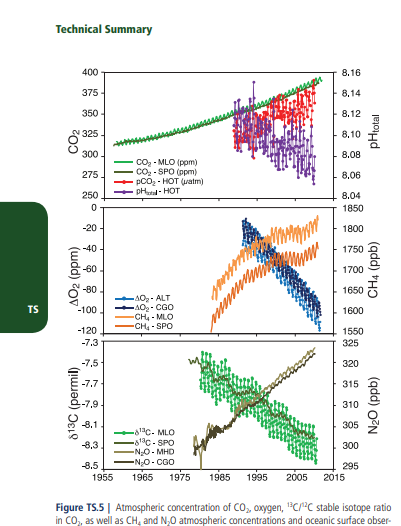
ttps://www.ipcc.ch/site/assets/uploads/2018/02/WG1AR5_all_final.pdf
It should be noted that the CO2 emitted from volcanoes is also low in 14^C- but the amount emitted by volcanoes is actually quite small relative to the amount emitted by humans as a result of burning fossil fuels. Two gigantic volcanic eruptions in the recent past- Mt. Pinatubo and Mt. St. Hellens, as examples, produced barely a blip in global CO2 concentrations measured at Mauna Loa. Let that sink in for a moment: we fossil fuel-burning humans are by far the biggest volcano on earth, in terms of emissions.
Again, that the new CO2 in the atmosphere is primarily a result of us burning fossil fuels and dumping the resulting CO2 into the atmosphere, is not in credible scientific dispute. It’s a fact, based on multiple replicate measurements which agree with one another. It’s a fact that we’ve known about for a long time too.
Fact #3: Extra CO2 (and other GHGs) Causes Climactic Forcing
This one again is not a supposition- it is a fact, arising from both an understanding of basic physics known since the late 1800s, and direct measurements.
Most of the atmosphere is NOT CO2. The atmosphere consists mostly of nitrogen, oxygen, argon and water vapour. CO2 is a minor constituent at only 415 ppm or 0.04%. But everyone should realize that a small concentration of something can have an out-sized effect. If you don’t believe this, breathe some air containing a very small amount – say 400 ppm or 0.04%- of carbon MONoxide…but please don’t do that! You should already know the outcome- and hopefully have a CO detector in your home too, to make sure you don’t do so by mistake.
(Note: CO2 is also toxic- carbon intoxication symptoms start at concentrations above about 5,000 ppm or 0.5%. That’s a far higher concentration than the atmosphere will ever get to, but it certainly can get that high in spaces particularly underground with poor ventilation.)
That is NOT to say, however, that CO2 is an unimportant constituent! It, along with water and solar energy, is one of the three primary fundamental building blocks of life on earth. It isn’t “plant food”, in exactly the same way that cement blocks aren’t food to construction workers. It contains zero useful chemical potential energy- a fact which makes it the desired product of processes intended to liberate chemical energy such as combustion or respiration. It’s merely a material that plants can collect and use solar photochemical energy to convert, along with water, into biomass. Having more building blocks at hand when CO2 concentrations are higher, simply means the plant has to expend less energy to build a given amount of biomass.
CO2 is also a strong absorber in the infrared. The earth receives solar energy at a range of wavelengths ranging from ultra long radio waves to high energy X rays- with the peak of the energy emitted in the visible wavelength band between 400 and 700 nm.
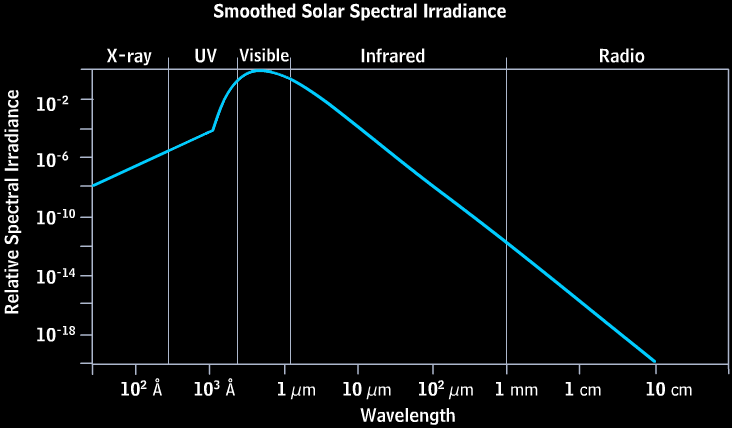
(picture: sun’s spectral irradiance)
https://www.windows2universe.org/sun/spectrum/multispectral_sun_overview.html
The magnetosphere and the upper atmosphere fortunately filter out a lot of the nastier, most damaging short wavelength radiation from the big fusion reactor in the sky before it gets to us on the surface.
Some is reflected, but the earth absorbs the remaining solar energy, with plants capturing only a small amount of it to store in the form of chemical potential energy. The rest, per the 1st law of thermodynamics, has to go somewhere. And that’s what happens- it ultimately goes back into outer space from whence it came. Because the earth is quite cold relative to the ball of radioactive fusion plasma in the sky, it re-radiates the energy absorbed by the sun not as short-wavelength UV or visible light, but as infrared (IR) light. The average solar energy input, minus whatever is stored in the form of biomass and hidden away from being eaten and respired again to CO2 and water, raises the average temperature of the earth until the amount of heat leaving through the atmosphere equals the amount falling on the earth.
Of course if this were all that was happening, the earth would be a snowball and humans wouldn’t exist…
Instead, the atmosphere absorbs some of the infrared energy radiated by the earth, and re-emits it back to the earth, giving us a 2nd exposure to some IR light that would otherwise be transmitted again to the blackness and cold of space. This partial absorption and re-emission of the radiative emissions of heat from the earth, back to the earth, by gases in the atmosphere, occurs mostly as a result not of CO2, but of water vapour. Water is also a strong IR absorber- and is the earth’s predominant “greenhouse gas” (GHG).
…but before you start to worry about water vapour emissions from your shower or teakettle warming the planet, remember that water vapour is in rapid physical equilibrium with liquid water in the oceans, soils and biosphere. The mean water vapour content of the atmosphere therefore depends on the mean global temperature, and is not meaningfully affected by human emissions of water vapour to the atmosphere.
The absorption spectrum of water vapour and the other “permanent” gases in the atmosphere has a “notch” in it- a range of wavelengths through which IR light can escape unimpeded.
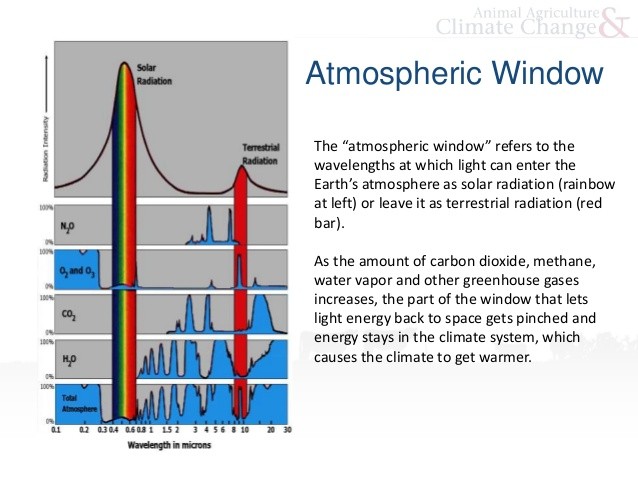
This is in part the reason that frost and condensation (such as dew) can happen when the air is at a bulk temperature higher than the dew point or the frost point. On a clear cloudless night, surfaces such as your car windshield have a narrow wavelength window through which they “see” the blackness of space at 4 kelvin above absolute zero- and hence can lose heat through this window, surprisingly dropping to a temperature lower than the ambient temperature. Special surfaces which enhance this re-emission are an interesting area of study for reducing energy consumption from cooling systems:
http://news.mit.edu/2018/device-provides-cooling-without-power-1128
This notch in the IR absorption spectra of the normal constituents of the atmosphere is called the IR re-radiative “window”. And it turns out that CO2, methane, N2O and a number of other gases, absorb IR strongly in this range of wavelengths along with others. They always have done. And we’ve known this for a long time- ever since we were able to measure the IR absorption spectra of these molecules- since around the late 1800s. These GHGs narrow the IR re-radiative wavelength window into outer space, making the earth “dimmer” as an IR emitter and requiring the earth’s mean temperature to rise until it can shove enough IR through the remaining portion of the window.
Of course this means that if we add EXTRA CO2, methane, N2O etc. to the atmosphere, this will narrow the IR re-radiative window even further. And that, obviously, forces the climate – it requires earth to warm to satisfy the new balance between the in-flow and out-flow of energy. Input minus output equals accumulation, and if we restrict the out-flow of IR from the earth to space, the earth MUST warm to satisfy the new balance point.
It is also true that a doubling of CO2 does not result in a doubling of the resulting climactic forcing- it’s much more complex than that. Extra CO2 does have somewhat diminishing returns as a greenhouse gas. Contrary to the claims of many denialists, however, the effect of extra CO2 is not “saturated”- as one easily found peer-reviewed reference states:
“We conclude that as the concentration of CO2 in the Earth’s atmosphere continues to rise there will be no saturation in its absorption of radiation and thus there can be no complacency with regards to its potential to further warm the climate.”
https://rmets.onlinelibrary.wiley.com/doi/pdf/10.1002/wea.2072
Warming also increases the amount of water vapour in the atmosphere- remember, water is still the primary GHG. That is a powerful positive feedback.
Note that so far we’ve discussed only CO2- but in reality, humans have also increased the amount of methane and of N2O and other GHGs too through our actions and inaction.
Three Facts- Not In Scientific Dispute
These three facts: CO2 went up, we caused it by burning fossils, and extra CO2 narrows the IR re-radiative wavelength window, forcing the climate – these are not in credible scientific dispute. Nobody is arguing about the fundamental validity of any one of the three of them in the scientific literature. It’s not that they’re scared to, or worried about losing their funding if they did- it’s simply not worth arguing over because it is so well demonstrated as fact, consistent with all the data we know of. And if you hear anyone denying any of these three facts, the conclusion is clear: they’re either ignorant, or they’re lying – to you, to themselves, or both. It’s that simple.
This is not a matter of orthodoxy, it’s a matter of simple measured fact.
Three Facts = RISK of AGW
The three facts I’ve pointed out lead inescapably to the conclusion that there is a very real, fact-based RISK of global warming caused by human activities (i.e. AGW). There can be no other conclusion.
It is of course perfectly valid to then say, “so what?” Let’s say that we accept that CO2 went up, we caused it, and the extra CO2 forces the climate. The last bit of wiggle-room for either denial or skepticism remaining is to claim that the resulting forcing will be minor, and hence not a problem for humans or the rest of the biosphere.
How does one translate the risk of AGW, which is certain, to a particular amount of warming of the earth? We do know the temperature must go up as a result of the facts we know, but how do we know by how much it is likely to increase? And how quickly that will happen?
The answer is that the earth is a complex system, with many inter-related factors, all of which can affect the climate in one direction or another, to a greater or a lesser degree. Some of these effects occur instantaneously, like the changes in the IR absorption. Some happen on a timescale of days, others years, others centuries, and others, millennia or even longer. And many of them are very much predictable.
Science therefore must have recourse to models, to estimate the effect of the additional radiative forcing on the earth’s mean temperature. Those models have to be very complex to tell us anything meaningful and reliable. And unfortunately, there are no replicate Earths available for us to do tests on, with an accelerated timescale so we can see results soon enough to understand our model’s validity.
And that’s where some skeptics hang their hats- they make the claim that climate models are fundamentally untestable, and hence not reliable enough to use to draw any conclusions from.
That statement however, fails on two basic points:
1) There IS a system on which we can test the validity of our models. That system is our earth in its recent PAST.
2) Merely being unable to precisely estimate a risk, in no way absolves us from the responsibility to act to mitigate that imprecisely-quantified but otherwise certain risk. Any engineer who has ever attended a Hazop review understands this fact intimately (or shouldn’t be involved in Hazop reviews!)
Some throw up their hands and say that it’s impossible to make decisions such as bringing to an end the burning of fossil materials such as coal, petroleum and natural gas, with the discharge of the effluent to the atmosphere, on the basis of something as unreliable as a model of the earth’s climate. But these people do not understand how we engineers make decisions related to risk as we practice our profession. We have a duty to hold the public safety as paramount- and that duty does not allow us to simply throw up our hands and say, “prove it!” before we will take a mitigating action.
We engineers see risk as the probability of a bad outcome, multiplied by the severity of the bad outcome. Merely bad things which are likely to happen very frequently are a high risk. And truly terrible things- like raising the mean temperature of the earth by, say, four degrees Celcius in a period of a century or so? Those things don’t need to have a very high probability of happening before we MUST take action because the risk is too high.
Others argue that global temperature measurements are difficult, or have been “manipulated”, and hence the data against which the models’ predictions are measured are suspect. Global mean temperature is a very hard thing to measure, and a very noisy signal. It’s also slow to respond- something as large as the accessible portion of the Earth has an enormous heat capacity. But those people are either conspiracy theorists, who think scientists are deliberately lying about climate change in order to further their careers (rather than being the one scientist who blows open such a conspiracy and gets a Nobel prize…), or they’re ignorant of just how many different measures of, and proxies for, global mean temperature have been used to check the models.
While my fundamental opinion is that we should defer to the knowledge and experience of the people who actually study the climate as their principal area of study in their area of expertise, I have seen a few compelling things that demonstrate to me that the models are in fact on the right track.
Here’s the first one: a clever animated infographic which shows that alternative explanations of the rise in global mean temperature that HAS in fact been observed, do not explain the increase. This uses, as I mentioned, the recent past of the earth as a means to test these various hypotheses of why the temperatures we’ve observed have in fact increased by the amount they have done:
https://www.bloomberg.com/graphics/2015-whats-warming-the-world/
No, it’s not the sun- the sun’s output DOES affect the climate, as do orbital and earth tilt cycles. But those things doesn’t explain the increases we’ve seen this time around either.
It’s not aerosol emissions from pollution or volcanoes, ground-level ozone, deforestation/land use changes etc. It’s clearly a result of the increased concentration of GHGs in the atmosphere. The risk is real- it’s having results on the earth’s climate.
The 2nd is this graphic for which I can thank @Mark Tingay for posting repeatedly in response to AGW denialists’ comments here on LinkedIn. It shows the consistency of the models with the measured temperature data, expressed as the “anomaly”, i.e. the excess of the reference 1980 temperature that has been measured:
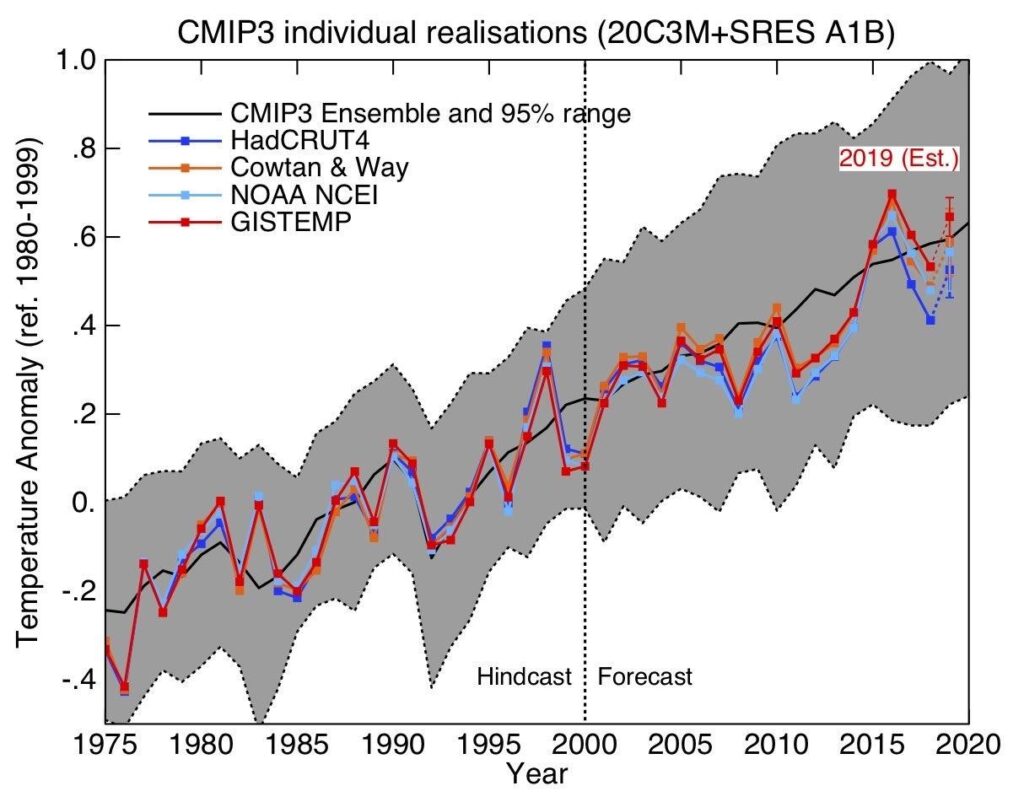
This is most up to date- from Gavin Schmidt’s Twitter feed. (He’s director of NASA’s Goddard Institute)
Both the models and the measurements of temperature have error bars on them, as does the risk resulting from the three facts I’ve discussed above. But here’s the key point: the error bars on these measurements and calculations do not extend to giving us hope of there being no effect, i.e. an effective risk of zero. And they certainly do not extend to giving us hope that we can continue to burn fossil fuels in the profligate way we’ve been doing for the past century or so, without the negative consequences of AGW.
We’re seeing rather clear, obvious evidence of those consequences even now- the temperatures have absolutely risen in a significant way. And it stands to reason, and to commonsense, that adding significantly more energy to a system like the earth’s climate, is going to have some serious negative outcomes- some of which, such as the melting of Arctic permafrost, themselves would be gigantic positive feedbacks on AGW, making it even worse. I’m not going to get into listing those impacts here- if you care to hear about the potential nightmare scenarios we could be generating for our progeny and theirs unless we smarten up and curtail our direct burning of fossils as fuels, you can find lots of that stuff elsewhere. Just ask that little Swedish girl that so many seem to be terrified and angered by. She’ll give you an earful- and yes, we all deserve it.
Many people who accept, perhaps grudgingly, the reality of the risk of AGW, are turned off the whole thing as a result of what they see as hyperbole used by those who want to convince us that AGW risk is a very serious issue which needs our prompt and serious attention. They react badly in particular to what they think is “alarmism”- for instance when someone says that we have less than 20 years to avert “global catastrophe”. I sympathize- the shrill rantings of uninformed people make me angry too, and I spend a lot of my time combatting the untruths, half-truths and distortions they are spreading on the Internet.
But it is important to clarify this one point: that we have limited time to avoid locking in potentially catastrophic warming. That point is consistent with the facts actually- but what isn’t being said, or perhaps isn’t being emphasized, is that they’re not saying that the catastrophic warming itself will be encountered in the next 20 years. It won’t be. The earth has a lot of heat capacity, so it heats slowly. It should therefore be no surprise that young people are most concerned about AGW and its effects- because they and their children will be the ones who live long enough to encounter them. We, their parents and grandparents, are not likely to be alive to experience the worst of those effects.
Final Thoughts About AGW and Conservatism
Sadly, some people are motivated to disapprove of AGW and pretend it’s not a problem out of a misguided notion of what it means to be “conservative” or “skeptical”.
Fossil fuels are a precious, finite resource- on the human timescale rather than the geological one. They are used to make ten thousand molecules and materials that are every bit as essential to modern life as energy is. And as someone who has helped people try to do this for a couple decades, I can say from first-hand professional experience that replacing some (many) of those molecules and materials with alternatives or substitutes derived from renewable resources is very difficult indeed- far more difficult than it is to make energy by renewable or non-emitting/low emission means.
Being “conservative” means valuing conservation, not being stodgy and unwilling to change or adapt, and certainly not being willfully blind toward new information when it comes to light. There is plenty of reason to conserve those precious, finite fossil resources for uses of highest value to humankind rather than squandering them as fuels. This would be true even if AGW were a total crock of horse effluent. Future generations will scold us not just for AGW, but also because we squandered their birthright in such a wasteful way and made their lives more difficult as a result.
Finally, being skeptical doesn’t mean rejecting anything you don’t understand. It certainly doesn’t mean relying on your current worldview entirely to inform you about what information you should accept as true and what you should reject as false. Being skeptical merely means being able to say “I don’t know” until you have sufficient proof to actually know. And there is no room for skepticism, whatsoever, in relation to the three facts which underpin the RISK of AGW. Your choice is to be either in denial of reality, or not. Please choose wisely!
Acknowledgements: thanks to @Mark Tingay and many others active here on LinkedIn for tirelessly chopping mutually inconsistent heads off the 9-headed hydra of climate change denial. Many give up, leaving the discussion floor to the denialists unchallenged and leaving the general public the view that there is room for doubt where there is none. It is a hard fight, but a worthwhile one.
Thanks also to Brian Dunning and this particular Skeptoid episode, which was the inspiration for this line of reasoning on my part. Skeptoid articles are fun to listen to, and give you the option to read instead if you, like me, read faster and more accurately than you listen:
https://skeptoid.com/episodes/4549
DISCLAIMER: everything I say here on LinkedIn is my own opinion. And my opinion is not infallible- and is subject to change when presented with new data with good references. If I’ve made any errors here- and I likely have- then by all means message me or comment to my article here and let me know where I’ve gone wrong. Do it respectfully though- if you go ad hominem, I’ll block you- life’s too short for that kind of horseshit.
Finally, my employer, Zeton Inc., takes no opinion in these matters, does not endorse my statements, and loves what it does- designing and building pilot plants for the whole breadth of the chemical process industry. If you take issue with anything I say, please take it up with me and leave Zeton out of it.
